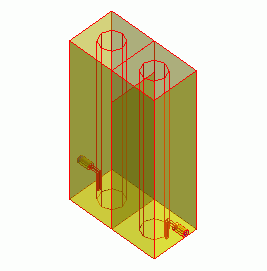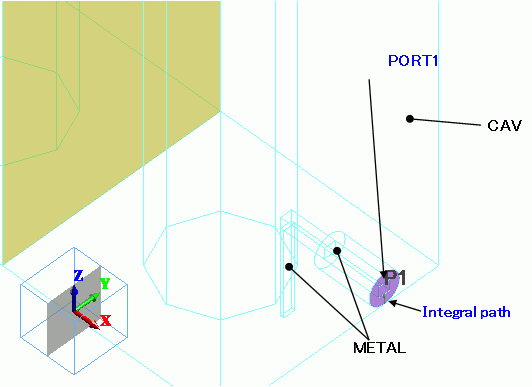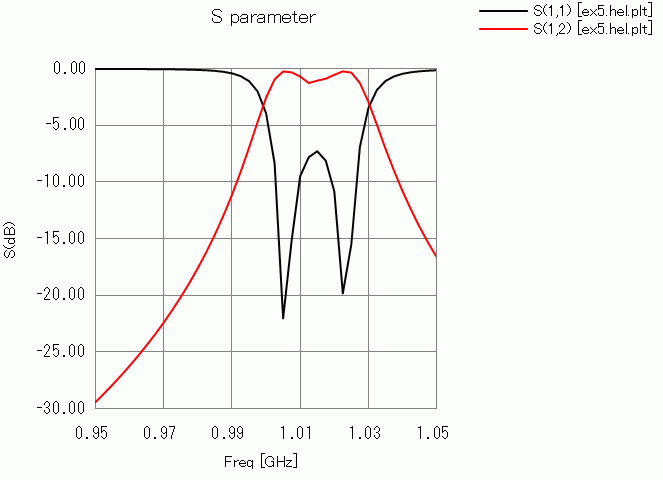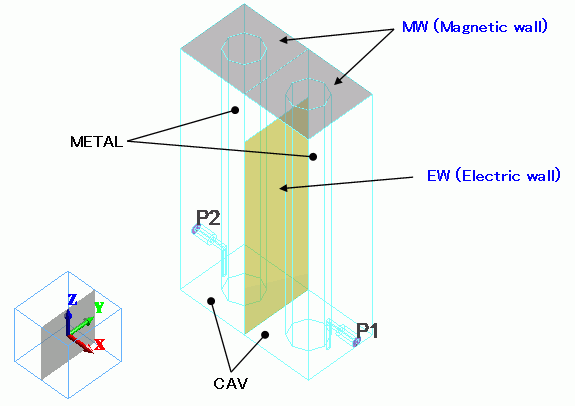
CAE Software【Femtet】Murata Software Co., Ltd.

Example5 Cavity Resonator

General
-
The model is a cavity resonator (1/4 wavelength coaxial).
-
The filtering characteristics of the resonator are solved.
-
Unless specified in the list below, the default conditions will be applied.
-
[How to Reduce the Calculation Time]
Analysis Space
|
Item |
Settings |
|
Analysis Space |
3D |
|
Model unit |
mm |
Analysis Conditions
|
Item |
Settings |
|
Solver |
Electromagnetic Analysis [Hertz] |
|
Analysis Type |
Harmonic analysis |
|
Options |
Select “Ignore the influence of face/edge electrode thickness” * |
* This is the default setting. There are no face electrodes with this model. Therefore it is irrelevant to select it or not.
xx
The harmonic analysis is set up as follows.
|
Tabs |
Setting Item |
Settings |
|
Mesh Tab |
Element type |
2nd-order element |
|
Multigrid/Adaptive Mesh Method |
Select “Use the adaptive mesh method”. |
|
|
Frequency-Dependent Meshing |
Reference frequency: 1×10^9[Hz] Select “The conductor bodies thicker than the skin depth constitute the boundary condition.”
The surface of Metal is treated as the boundary condition having some loss, as Metal is thicker than the skin depth. |
|
|
Harmonic analysis |
Frequency |
Minimum: 0.95×10^9[Hz] Maximum: 1.05×10^9[Hz] |
|
Sweep Type |
Select “Linear step” Division number: 40 |
|
|
Sweep Setting |
Select Fast sweep |
|
|
Input |
1.0[W} |
Model
The model consists of 2 cavity resonators with one end open. The resonators are coupled through the coupling window and also with the magnetic loop externally.
It is a 2-stage filter.
The whole model
The detail around I/O port

Body Attributes and Materials
The boolean operation is not performed for CAV and METAL,
even though they are overlapping. The boolean will be done automatically during meshing.
Body #4 is an imprinting body to apply the “electric wall” boundary condition on.
|
Body Number/Type |
Body Attribute Name |
Material Name |
|
0/Solid |
CAV |
000_Air(*) |
|
1/Solid |
METAL |
008_Cu * |
|
2/Solid |
METAL |
008_Cu * |
|
3/Solid |
CAV |
000_Air(*) |
|
4/Sheet |
Imprinting body |
|
|
5/Solid |
METAL |
008_Cu * |
|
6/Solid |
METAL |
008_Cu * |
|
8/Solid |
CAV |
000_Air(*) |
|
9/Solid |
METAL |
008_Cu * |
|
10/Solid |
METAL |
008_Cu * |
|
11/Solid |
METAL |
008_Cu * |
|
14/Solid |
METAL |
008_Cu * |
|
15/Solid |
CAV |
000_Air(*) |
* Available from the Material DB
Boundary Conditions
The I/O port boundary conditions (PORT1, PORT2) are set on the I/O ports of the filter.
The integral path is required between the hot and the ground for two-conductor ports.
The integral path is used to calculate the characteristic impedance of the port.
S-parameters can be converted based on the characteristic impedance.
|
Boundary Condition Name/Topology |
Tab |
Boundary Condition Type |
Settings |
|
PORT1/Face |
Electric |
I/O Port |
Reference Impedance: Number of Modes Number of precalculated modes: 5 Number of modes used in the actual analysis: 1 Select modes: none |
|
PORT2/Face |
Electric |
I/O Port |
Same as PORT1 |
|
EW/Face |
Electric |
Electric wall |
|
|
MW/Face |
Electric |
Magnetic wall |
|
|
Outer Boundary Condition |
Electric |
Electric wall |
|
The outer boundary of air:
The outer boundary of air is set as the electric wall, which is the perfect conductor.
Results
The S-parameters plots are shown below.

The pass band is around 1.01[GHz].


